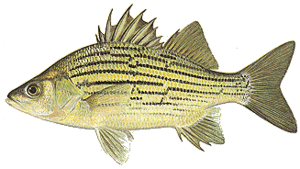Yellow bass facts for kids
Quick facts for kids Yellow bass |
|
|---|---|
 |
|
| Conservation status | |
| Scientific classification | |
| Synonyms | |
|
The yellow bass (scientific name: Morone mississippiensis) is a cool fish that belongs to the Moronidae family. It has a deep body and usually sports five to seven dark stripes along its sides. Some of these stripes near its belly might look broken.
This fish looks a bit like its relatives, the white bass and the striped bass. You can tell a yellow bass apart because its stripes above the anal fin are a bit off-center. Also, it doesn't have rough patches on its tongue like some other fish. Another way to tell it apart from the white bass is by counting the rays on its anal fin; the yellow bass has nine or ten, while the white bass has more. Its back is often a dark olive green, and its sides and belly are usually a shiny silvery yellow.
Contents
What the Yellow Bass Eats
Young yellow bass start their diet with tiny creatures. These include very small invertebrates like copepods and different kinds of aquatic insects. As they grow bigger, young yellow bass mostly eat aquatic insects and small crustaceans. When they become adult fish, their main food source changes. They mostly eat other small fish, but they still enjoy some small crustaceans too.
Where Yellow Bass Live
You can find yellow bass in fairly clear waters. They live in the Mississippi River all the way from Minnesota down to Louisiana. They also make their home in the Trinity River and the Tennessee River. These fish also like to live in lakes that are connected to these rivers. They especially prefer areas in lakes that have lots of plants and water that isn't too cloudy.
Reproduction and Life Cycle
The way yellow bass reproduce is similar to how white bass do it. They usually spawn, or lay their eggs, during the spring season. During this time, the fish swim into smaller streams and rivers to find good spots. Spawning often happens in water that isn't too deep. The female fish will lie on her side to show her eggs, and the male fish will fertilize them from above.
After the eggs hatch, the baby yellow bass, called larvae, swim together in large groups. This helps them stay safe from other fish that might try to eat them. These young fish grow pretty quickly. On average, a yellow bass lives for about six years.
Why Yellow Bass are Important to People
The yellow bass is not as popular for sport fishing as the white bass or the striped bass. This is mainly because yellow bass are smaller in size. People who fish for them often use small lures called crappie jigs or live minnows. Since there are usually many yellow bass, anglers can often catch a lot of them at once. Yellow bass are good to eat, and people in the areas where they live often enjoy them as food.
About the Name
The second part of the yellow bass's scientific name, mississippiensis, tells us something about where it lives. It comes from the Mississippi River, which is a major river where these fish are found.


